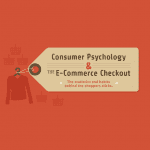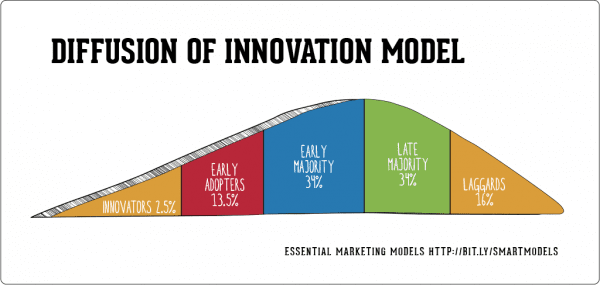Using the Diffusion of Innovation (DOI) to engage with different types of buyers when new products are launched
What is The Diffusion of Innovation?
This model helps a business to understand how a buyer adopts and engages with new products or technologies over time. Companies will use it when launching a new product or service, adapting it or introducing an existing product into a new market.
It shows how the product can be adopted by five different categories/customer types and how to engage as a business with these types of people:
Â
Of course, the emergence of new digital technologies and marketing techniques means that the diffusion of innovation model is particularly relevant to digital marketers. Analysts Gartner have a long standing report showing the stages of adoption of new technologies that is useful for digital strategists to follow. See our post on the Latest Gartner Digital Technology Hype Cycle.Â
Returning to the DOI, what characterises each of the groups of adopters, in general they have these characteristics, see the original work by Everett M. Rogers for more details.Â
- 1. Innovator. They are a small group of people exploring new ideas and technologies. It includes “gadget fetishists!†In an online marketing context there are a lot of specialist blogs and media sites to engage them, Engadget and Gizmodo for examples.
- 2. Early Adopters. Considered to be Opinion Leaders who may share positive testimonials about new products and services, seeking improvements and efficiency. Engagement requires little persuasion as they’re receptive to change. Provide guides on how to use the product/service.
- 3. Early Majority. These are Followers who will read reviews by earlier adopters about new products before purchasing. They can be engaged with reviews and via YouTube, where they will look for your products.
- 4. Late Majority. To generalise, these are sceptics who are not keen on change and will only adopt a new product or service if there is a strong feeling of being left behind or missing out. They can be engaged with providing marketing material, evidence, reviews from Opinion Leaders and case studies to show how it works.
- 5. Laggards. The descriptor says it all! Typically they prefer traditional communications and will adopt new products when there are no alternatives. Laggards will come on board when ‘others’ have written about your products/services, they have research evidence, statistics or felt pressure from others.
How to use the Diffusion of Innovation?
If you are launching a new tech product, such as software, you can use this model which will help with identifying the marketing materials needed for each group.
The Adoption theory is most useful when looking at new product launches, but it can be useful when taking existing products or services into a new market.
Examples of how it can be applied to digital marketing strategies?
This is an example based on launching new software to the different groups.
- Innovator: Show the software on key software sites such as Techcrunch, or Mashable. Providing marketing material on the website, with relevant information and lead to potential sales with downloads.
- Early Adoptor:Â Create guides and add to the major software sites, providing marketing material such as case studies, Guides and FAQs.
- Early Majority: Blogger outreach with guest blog posts and provide links to social media pages, key facts and figures, and ‘how to’ YouTube videos.
- Late Majority: Encourage reviews, comparisons and share press commentary on your website. Provide a press section and social proof with information and links to reviews, testimonials, third party review sites etc
- Laggards: It’s probably not worth trying to appeal to this group!
What to watch for?
The Adoption theory is mainly useful when developing new products. If you’re in FMCG and launch many new products or lines a year, it may be less effective as it’s not practical to create individuals strategies for hundreds of products.
By Annmarie Hanlon. Annmarie Hanlon is the Smart Insights expert commentator on online and offline marketing strategies for business.
Original sources
Rogers, E.M. (1976). New Product Adoption and Diffusion. Journal of Consumer Research. (March). p290-301.
Â




 The 34m Americans planning to buy a vehicle in the next six months are twice as likely to be swayed by auto-focused digital marketing as the population at large according to new research.
The 34m Americans planning to buy a vehicle in the next six months are twice as likely to be swayed by auto-focused digital marketing as the population at large according to new research.


 Day 2 of New Media Expo 2014 from the Rio got underway with morning keynote speaker Scott Stratten, president of UnMarketing, discussing the topic of QR codes and marketing strategies in general during his presentation “QR Codes Kill Kittens: How to Alienate Customers, Dishearten Employees and Drive Your Business into the Ground.â€
Day 2 of New Media Expo 2014 from the Rio got underway with morning keynote speaker Scott Stratten, president of UnMarketing, discussing the topic of QR codes and marketing strategies in general during his presentation “QR Codes Kill Kittens: How to Alienate Customers, Dishearten Employees and Drive Your Business into the Ground.â€



 Is there such a thing as failing profitably? In the world of lead generation, this may sound like a very dangerous idea. After all, the only real measure for a company’s continued survival is its success inÂ
Is there such a thing as failing profitably? In the world of lead generation, this may sound like a very dangerous idea. After all, the only real measure for a company’s continued survival is its success inÂ